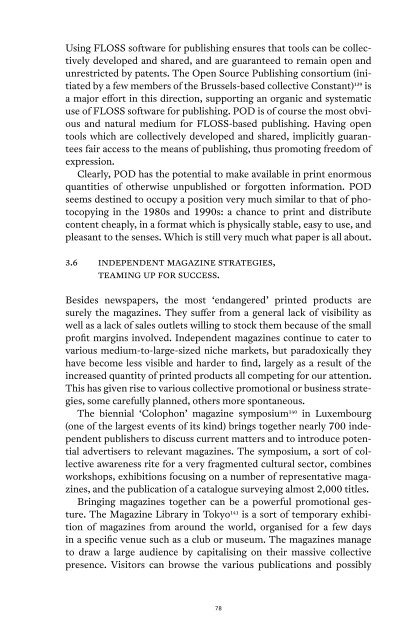Post- Digital Print - Monoskop
Post- Digital Print - Monoskop
Post- Digital Print - Monoskop
You also want an ePaper? Increase the reach of your titles
YUMPU automatically turns print PDFs into web optimized ePapers that Google loves.
Using FLOSS software for publishing ensures that tools can be collectively<br />
developed and shared, and are guaranteed to remain open and<br />
unrestricted by patents. The Open Source Publishing consortium (initiated<br />
by a few members of the Brussels-based collective Constant) 139 is<br />
a major effort in this direction, supporting an organic and systematic<br />
use of FLOSS software for publishing. POD is of course the most obvious<br />
and natural medium for FLOSS-based publishing. Having open<br />
tools which are collectively developed and shared, implicitly guarantees<br />
fair access to the means of publishing, thus promoting freedom of<br />
expression.<br />
Clearly, POD has the potential to make available in print enormous<br />
quantities of otherwise unpublished or forgotten information. POD<br />
seems destined to occupy a position very much similar to that of photocopying<br />
in the 1980s and 1990s: a chance to print and distribute<br />
content cheaply, in a format which is physically stable, easy to use, and<br />
pleasant to the senses. Which is still very much what paper is all about.<br />
3.6 independent magazine strategies,<br />
teaming up for success.<br />
Besides newspapers, the most ‘endangered’ printed products are<br />
surely the magazines. They suffer from a general lack of visibility as<br />
well as a lack of sales outlets willing to stock them because of the small<br />
profit margins involved. Independent magazines continue to cater to<br />
various medium-to-large-sized niche markets, but paradoxically they<br />
have become less visible and harder to find, largely as a result of the<br />
increased quantity of printed products all competing for our attention.<br />
This has given rise to various collective promotional or business strategies,<br />
some carefully planned, others more spontaneous.<br />
The biennial ‘Colophon’ magazine symposium 140 in Luxembourg<br />
(one of the largest events of its kind) brings together nearly 700 independent<br />
publishers to discuss current matters and to introduce potential<br />
advertisers to relevant magazines. The symposium, a sort of collective<br />
awareness rite for a very fragmented cultural sector, combines<br />
workshops, exhibitions focusing on a number of representative magazines,<br />
and the publication of a catalogue surveying almost 2,000 titles.<br />
Bringing magazines together can be a powerful promotional gesture.<br />
The Magazine Library in Tokyo 141 is a sort of temporary exhibition<br />
of magazines from around the world, organised for a few days<br />
in a specific venue such as a club or museum. The magazines manage<br />
to draw a large audience by capitalising on their massive collective<br />
presence. Visitors can browse the various publications and possibly<br />
78

















